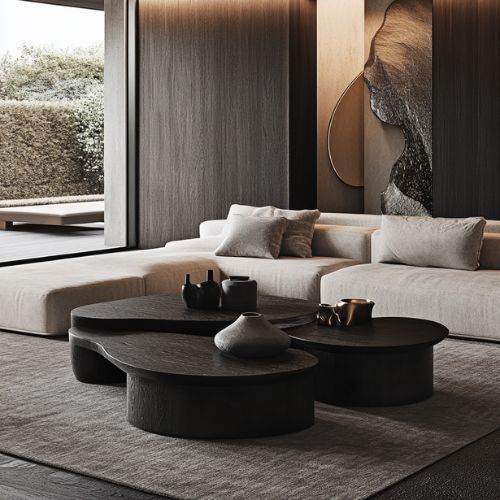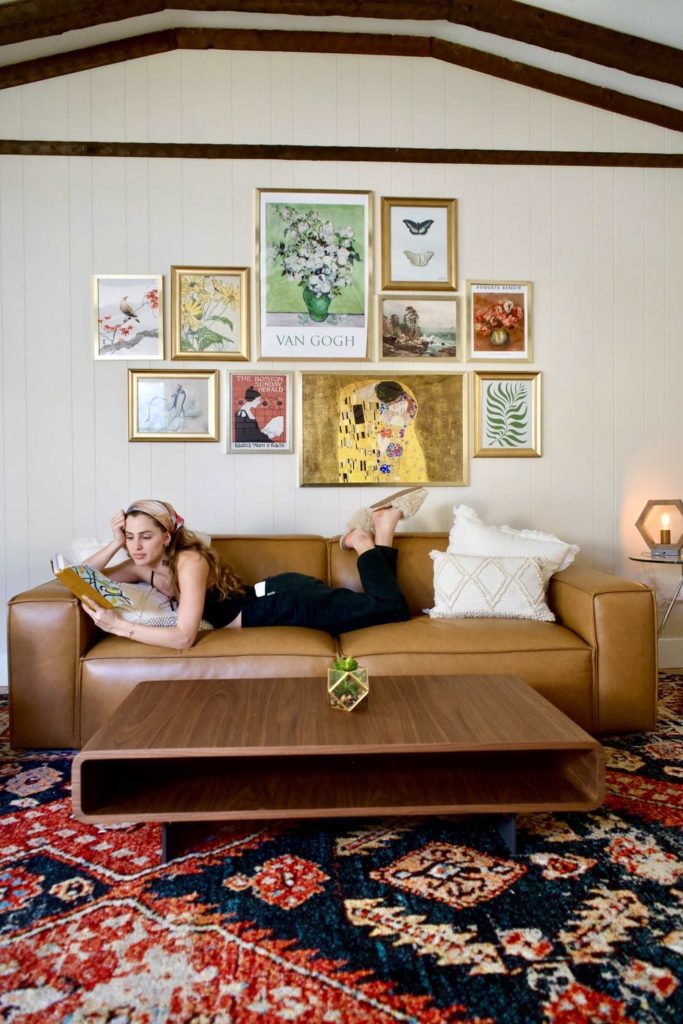Have you ever wondered if your coffee table can be higher than your sofa? It’s a simple question, but the answer can change how your living room feels and functions.
You might think the coffee table should always be lower, but what if breaking that rule could make your space more comfortable and stylish? Keep reading to discover why the height of your coffee table matters and how you can find the perfect balance for your home.
This small detail could make a big difference in your everyday comfort and the look of your room.
Ideal Coffee Table Height
Choosing the right coffee table height matters for both style and comfort. The ideal height makes your living space look balanced. It also helps you reach drinks or books without strain. Picking a height too tall or short can make your room feel off.
Standard Measurements
The most common coffee table height is between 16 and 18 inches. Sofas usually have seat heights from 17 to 19 inches. This range keeps the table slightly lower than the sofa seat. It fits most living rooms and looks natural.
| Furniture | Typical Height |
|---|---|
| Coffee Table | 16 to 18 inches |
| Sofa Seat | 17 to 19 inches |
Sticking to these heights keeps your setup comfortable and stylish.
Comfort And Accessibility
A coffee table higher than the sofa seat can cause discomfort. It may block leg space or feel awkward to reach. A table at or just below sofa height allows easy access. It lets you place items without stretching or bending.
- Table too high: hard to reach, uncomfortable
- Table too low: may feel less functional
- Ideal: level with or slightly below sofa seat
Good coffee table height supports relaxation and smooth use.
Effects Of A Taller Coffee Table
Choosing a coffee table taller than your sofa can change the whole vibe and function of your living space. It’s not just about style; it affects how you interact with the room and the furniture around it. Let’s look closer at what happens when your coffee table stands higher than your sofa.
Visual Impact
A taller coffee table grabs attention immediately. It breaks the usual line of sight, making the space feel less traditional and more dynamic.
But how does this affect your room’s balance? A higher table can make your sofa appear smaller or more grounded. This shift can be good if you want to highlight the table as a centerpiece.
Think about the materials and colors too. A tall table with a light finish can brighten the room, while a dark, bulky one might weigh down the space visually. Have you noticed how a taller table can either open up or crowd your seating area?
Practical Considerations
Functionality matters. A taller coffee table changes how you use it daily. Reaching for a drink or a book might feel different, possibly less comfortable if the table is too high.
Consider your sofa’s height and your usual seating posture. If you lean back deeply, a tall table might be awkward to use. But if you sit upright, it could work well and even reduce strain on your back.
Also, taller tables offer more storage options underneath, but only if designed smartly. Could the height allow for stools or extra seating to tuck underneath? This might be a clever way to save space.
Design Styles That Suit Taller Tables
Taller coffee tables can complement modern and minimalist design styles well. Choosing sleek, simple shapes helps balance higher tables with sofas. Light colors and slim legs keep the look open and comfortable.
Design Styles That Suit Taller Tables When considering a coffee table that’s higher than your sofa, design style plays a crucial role. The right style can transform a seemingly unconventional choice into a statement piece that enhances your living space. Let’s explore which design styles are a perfect match for taller tables.Modern And Contemporary
Modern and contemporary styles are all about sleek lines and minimalism. A taller coffee table can become a focal point in a modern living room, emphasizing clean surfaces and a clutter-free environment. Imagine pairing a high glass-top coffee table with a low-profile sectional sofa. The contrast draws the eye and adds a layer of sophistication. You might find that the extra height even makes it more functional for activities like working on your laptop or enjoying a meal.Eclectic And Statement Pieces
In an eclectic space, rules are meant to be bent and broken. A taller coffee table can serve as a bold statement piece, adding character and uniqueness to your living area. Consider a vintage or upcycled table that stands out with vibrant colors or intricate details. This can be the perfect conversation starter at your next gathering. The height difference between your sofa and table adds an unexpected twist that reflects your personality and taste. Are you ready to rethink the traditional norms of living room design? The right style choice can make a taller coffee table not just a functional element, but a captivating addition to your home.
Credit: stylebyemilyhenderson.com
Safety And Functionality
Choosing a coffee table taller than your sofa might seem like a bold style move, but safety and functionality should always guide your decision. If not carefully planned, this setup can create hazards or make your living space less comfortable. Let’s look at how you can keep your room safe and practical while experimenting with table height.
Avoiding Hazards
A coffee table higher than the sofa can easily become a tripping or bumping risk. Sharp edges at head level invite painful accidents, especially in tight spaces.
- Check the height difference carefully; ideally, the table should not exceed the sofa’s seat height by more than 2-3 inches.
- Opt for rounded corners or protective edge guards to soften any potential impact.
- Keep pathways clear around the table to prevent stumbles when moving around.
Have you ever bumped your knee or shin on a piece of furniture? That small discomfort can be avoided with thoughtful design choices.
Maintaining Usability
Your coffee table should make relaxing easier, not harder. If it’s higher than your sofa, reaching for a drink or snack might feel awkward or strain your arms.
- Choose a table height that complements your sofa’s armrest or seat height for comfortable reach.
- Consider the table’s purpose—will you use it for work, dining, or just decoration? This affects the ideal height.
- Test the setup by sitting and reaching out; if you have to stretch or bend uncomfortably, it’s too high.
Think about your daily habits. Does your current coffee table support your lifestyle, or does it create little annoyances you’ve grown used to?
Tips For Choosing The Right Height
Choosing the right height for a coffee table is key to a comfortable and stylish living room. A table that is too tall or too low can disrupt the room’s flow and make daily use awkward. Finding the perfect height balances function with design, enhancing your space’s overall feel.
Measuring Your Space
Start by measuring the height of your sofa seat from the floor to the top of the cushion. The coffee table should usually be about the same height or slightly lower than the sofa seat. Leave enough space between the sofa and the table for easy movement, typically 12 to 18 inches. Measure the length and width of the area to ensure the coffee table fits comfortably without crowding.
Matching Furniture Proportions
Choose a coffee table that complements the size and style of your sofa. A large sofa pairs well with a wider, taller table to maintain balance. For smaller sofas, a lower or narrower table works best. Consider the shapes too—round tables soften sharp sofa edges, while rectangular tables echo straight lines. Keep proportions in mind to create a cohesive look that feels inviting and functional.

Credit: www.castlery.com
Alternatives To Traditional Coffee Tables
If you find a traditional coffee table too low or simply want to mix up your living space, there are plenty of alternatives to consider. Choosing the right piece can enhance both comfort and style. These options let you tailor your room to fit your lifestyle and aesthetic perfectly.
Ottomans And Poufs
Ottomans and poufs offer a soft, versatile alternative to a hard coffee table surface. They can be used as extra seating, a footrest, or even as a place to set a tray with drinks and snacks. Their height often matches or slightly exceeds sofa seats, which might solve your problem if you want a higher surface.
Think about adding a sturdy tray on top to create a flat surface. This way, you get the best of both worlds—comfort and functionality. Plus, ottomans with hidden storage can help you keep your living area tidy.
Side Tables And Nesting Tables
Side tables and nesting tables are excellent if you want flexibility and height variation. You can place them next to your sofa or cluster them together in front for a unique setup. Their heights often range from sofa arm level to higher, giving you the chance to customize your space.
These tables are perfect if you need multiple surfaces for different purposes—drinks, books, or decorative items. Nesting tables slide under each other, saving space when you don’t need them all out. Have you tried mixing different shapes or materials for a more dynamic look?

Credit: www.fcilondon.co.uk
Frequently Asked Questions
Can A Coffee Table Be Taller Than The Sofa?
Yes, a coffee table can be taller, but it may affect comfort and aesthetics. Ideally, the table should be slightly lower or equal to the sofa seat height for easy reach and balanced look.
What Is The Ideal Coffee Table Height Compared To Sofa?
The ideal coffee table height is 1-2 inches below the sofa seat height. This ensures comfort while reaching for items and maintains a cohesive room design.
Does A Taller Coffee Table Affect Room Space?
A taller coffee table can make the room feel cluttered and reduce legroom. Choose a height that complements sofa size and room layout for better flow.
How To Style A Coffee Table Higher Than Sofa?
Use taller decor items to balance the height difference. Keep accessories minimal to avoid overwhelming the space and maintain a harmonious look.
Conclusion
A coffee table higher than the sofa can work well in some spaces. It adds style and can be practical for certain needs. Comfort and balance matter most when choosing table height. Think about how you use the table every day.
Small changes can make a big difference in your room. Try different setups to see what feels right. Your home should feel cozy and fit your lifestyle. Simple choices create a space you enjoy.





